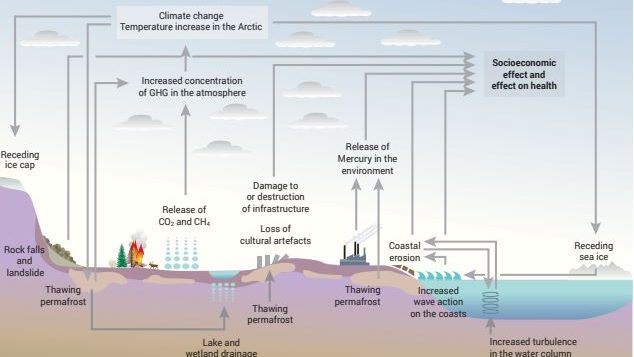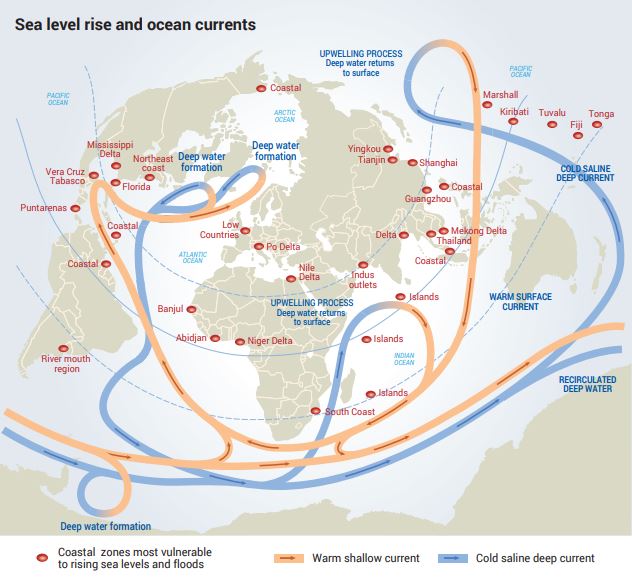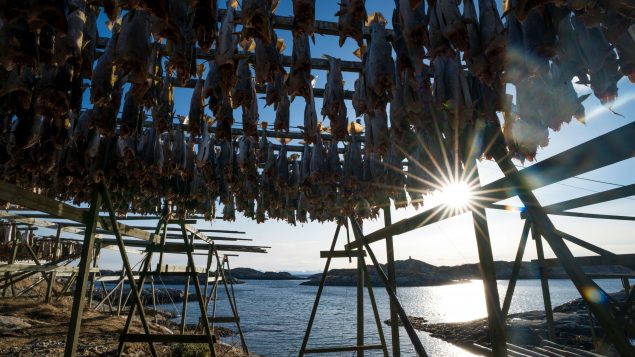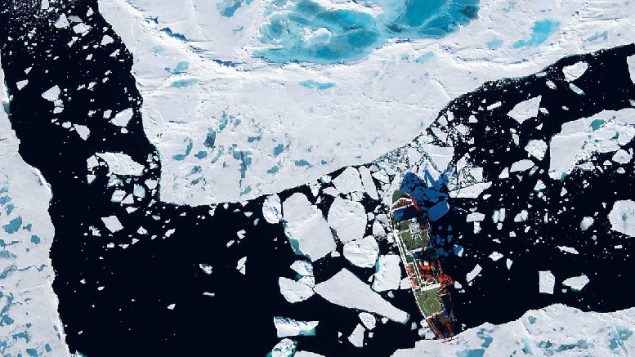Winter temperatures in the Arctic are set to rise by 3 to 5 C by 2050 even if the world succeeds in cutting emissions in line with the Paris Agreement, according to a new report by the United Nations.
These temperatures are set rise even higher – up to 9 C – by 2080, bringing devastating changes to the region and triggering sea level rises worldwide, the report by UN Environment finds.
Further warming may also surpass tipping points for the stability of the Greenland ice sheet, as well as the rapidly melting permafrost, which could release large amounts of carbon into the atmosphere and derail efforts to meet global greenhouse gas emission goals.
Other possible tipping points are related to increased fresh water input or ocean acidification, with direct impacts on ocean circulation and ecosystems, warns the report titled Global Linkages – A graphic look at the changing Arctic.
“What happens in the Arctic does not stay in the Arctic,” said in a statement Joyce Msuya, UN Environment’s Acting Executive Director. “We have the science; now more urgent climate action is needed to steer away from tipping points that could be even worse for our planet than we first thought.”
Even if all carbon emissions were to be halted immediately, winter temperatures in the Arctic would still increase 4 to 5 C by the end of the 21st century compared to the late 20th century, the study finds. That’s because of greenhouse gases already emitted and stored in the world oceans.

Source: UN Environment
But it’s not just about reducing carbon emissions.
“Longer-term efforts to transition to low-carbon economies, both in the Arctic and globally, must be complemented by instant measures to reduce Short-Lived Climate Pollutants (SLCP), including methane, tropospheric ozone and black carbon,” the study says. “Immediately controlling SLCPs across the world could cut the rate of warming in the Arctic by up to two-thirds by mid-century.”
The report warns that Arctic societies, especially Indigenous Peoples who already face increased food insecurity, must prepare for what’s coming with suitable adaptation actions.
By mid-century nearly four million people, and about two-thirds of today’s Arctic infrastructure, will be threatened by thawing permafrost, the report warns.
Global impacts

Source: UN Environment
The Arctic region has a significant impact on the global climate and there are strong feedback mechanisms between the Arctic and the rest of the world, the study says.
From 1979 to the present, Arctic sea ice is estimated to have declined by 40 per cent. Climate models predict that, at the current rate of carbon dioxide emissions, Arctic summers will be ice-free by the 2030s, according to the report.
“Global emissions drive the melting of ice caps and glaciers, significantly contributing to rising sea levels, which will affect coastal and island communities throughout the world,” the report says.
The melting of the Greenland ice cap and Arctic glaciers contribute to one third of sea level rise worldwide.
The slightest change in temperature can have a substantial effect on the fragile ecosystems in the Arctic, which is home to over 21,000 species of plants, fungi, mammals, birds, fish, insects and invertebrates, the report says.
“This makes climate change the most serious threat to biodiversity in the Arctic.”
Ocean acidification is another threat

Arctic cod pictured in northern Norway in 2018. The increase in ocean CO2 has caused average ocean surface acidity to increase by 30 per cent since the beginning of the industrial revolution, according to a new UN report. (Olivier Morin/AFP/Getty Images)
Growing ocean acidification is another factor impacting Arctic marine species.
“The increase in ocean CO2 has caused average ocean surface acidity to increase by 30 per cent since the beginning of the industrial revolution,” the report said.
“Lower pH levels can affect life in the ocean: for example, sea creatures like corals, molluscs, sea urchins and plankton build their shells and skeletons from aragonite, a carbonate mineral. This mineral becomes less available when pH levels of seawater fall, meaning these creatures need more energy to build their shells.”
Far from pristine

The German icebreaking research vessel Polar Stern taking samples across the Arctic in 2014-2015. (Stefanie Arndt/AWI)
Despite its pristine image in the popular imagination, the Arctic’s geographical characteristics and cold climate mean the region’s ocean, seafloor and coastline are a sink for contaminants from around the globe, the report says.
Only 1,000 out of the 150,000 chemical substances in use worldwide are regularly monitored. A global approval system for new chemicals is therefore needed, the report argues.
Alternative controls are also seen as necessary for chemicals that fall outside of existing treaties.
The report notes, however, that amount of regulated chemicals in humans and animals living in the Arctic was found to be decreasing. These include some Persistent Organic Pollutants (POB) regulated under UN Environment’s Stockholm Convention. However, the decrease could be due to changing diets, the report speculates.
The report also warns of other threats such as plastic pollution, invasive species and new diseases appearing in the region.







For reasons beyond our control, and for an undetermined period of time, our comment section is now closed. However, our social networks remain open to your contributions.